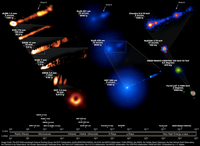Multi-wavelength Properties of M87
 The Event Horizon Telescope (EHT) Collaboration succeeded in capturing the first direct image of the center of the M87 galaxy. The asymmetric ring morphology and size are consistent with theoretical expectations for a weakly accreting supermassive black hole of mass ∼6.5 × 109M⊙. The Collaboration partnered with several international ground- and space-based facilities for an extensive, quasi-simultaneous multi-wavelength campaign. This Letter presents the results and analysis of this campaign, as well as the multi-wavelength data as a legacy data repository. The EHT Collaboration captured M87 in a historically low state, and the core flux dominates over HST-1 at high energies, making it possible to combine core flux constraints with the more spatially precise very long baseline interferometry data. The authors present the most complete simultaneous multi-wavelength spectrum of the active nucleus to date, and discuss the complexity and caveats of combining data from different spatial scales into one broadband spectrum. The Very Long Baseline Array and the Atacama Large Millimeter/submillimeter Array played key roles in this multi-wavelength campaign.
The Event Horizon Telescope (EHT) Collaboration succeeded in capturing the first direct image of the center of the M87 galaxy. The asymmetric ring morphology and size are consistent with theoretical expectations for a weakly accreting supermassive black hole of mass ∼6.5 × 109M⊙. The Collaboration partnered with several international ground- and space-based facilities for an extensive, quasi-simultaneous multi-wavelength campaign. This Letter presents the results and analysis of this campaign, as well as the multi-wavelength data as a legacy data repository. The EHT Collaboration captured M87 in a historically low state, and the core flux dominates over HST-1 at high energies, making it possible to combine core flux constraints with the more spatially precise very long baseline interferometry data. The authors present the most complete simultaneous multi-wavelength spectrum of the active nucleus to date, and discuss the complexity and caveats of combining data from different spatial scales into one broadband spectrum. The Very Long Baseline Array and the Atacama Large Millimeter/submillimeter Array played key roles in this multi-wavelength campaign.
The Collaboration applied two heuristic, isotropic leptonic single-zone models to provide insight into the basic source properties, but concluded that a structured jet is necessary to explain the M87 spectrum. The authors excluded that the simultaneous γ-ray emission is produced via inverse Compton emission in the same region producing the EHT mm-band emission, and further concluded that the γ-rays can only be produced in the inner jets (inward of HST-1) if there are strongly particle-dominated regions. Direct synchrotron emission from accelerated protons and secondaries cannot yet be excluded.
Image Caption: To better understand the black hole at the core of galaxy M87, the EHT Collaboration mounted a multi-wavelength observing campaign. Observations across the electromagnetic spectrum in radio, visible-light, ultraviolet, X-ray, and gamma-ray revealed the far-reaching impact of the supermassive black hole on its surroundings.
Publication: EHT Collaboration, Broadband Multi-wavelength Properties of M87 during the 2017 Event Horizon Telescope Campaign, Astrophysical Journal Letters, 911, L11 (April 2021).
NRAO Press Release: VIDEO: Multi-wavelength Observations Reveal Impact of Black Hole on M87 Galaxy




Connect with NRAO